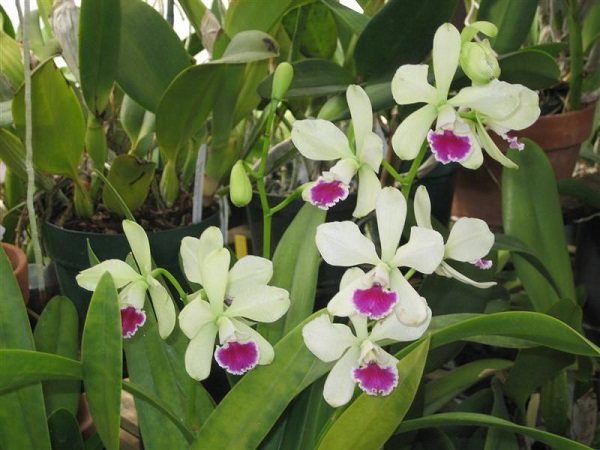Orchids are one of the two largest families of flowering plants in the plant kingdom. Most are classified as Epiphytes, meaning they grow upon some other substrate for support; they are not, however, parasitic, as they derive no nutritional value from anything they grow upon. Others are terrestrial; they grow and live in the earth, not upon anything else. The flowers range from exotic and bizarre to plain, downright, stunningly gorgeous, to as many as hundreds of blooms on one plant to merely one. Some Orchids are the size of a pinhead and others as large as your hand. Flower color can run the gamut of the rainbow, in essentially every color except true blue and black. Orchid flowers can be incredibly fragrant, especially at night, when their fragrance lures the nighttime pollinators.

Although there are thousands of different genera of Orchids, the most common and most popularly grown in the home or in a greenhouse are:
Cattleya and its family
Phalaenopsis (Moth Orchid)
Cymbidium (not recommended for indoor culture)
Cypripedium & Paphiopedilum (Ladyslippers)
Dendrobium
Oncidium
Vanda
A Very Simple and Basic How To for Orchid Culture
All orchids require certain things for life and growth: air, light, water, and food.
Give your plant as much light as it will stand. Light into your greenhouse is measured in foot-candles. Your hand held above the leaves should create a light shadow; a light meter (even from a camera) is a very useful tool. Light is measured in footcandles and will vary from the type of plant you choose to grow. The leaves should be a pale light green color. Dark green, lush looking leaves make a nice-looking plant, but it will never bloom. Based upon the type of Orchid you choose to grow, you must meet its basic cultural needs and the more you’re able to mimic its natural conditions, the more success you’ll have. Air movement is critical. Orchids typically grow high in the forest canopy that is subjected to constant air movement.
Temperature and Humidity
Based upon the plant you choose to grow you’ll need to adjust its growing condition accordingly. Maintain humidity to at least 50% and provide the appropriate temperature, based upon warm, intermediate, or cool.
Water your plant when it’s dry, simple as that. If it feels light in its pot, chances are it needs some water. If you must err, err on the side of dry. Most Orchids can go quite some time without water and are adapted to dry periods in their natural environment. Watering should be done as early in the day as possible but in any case, be absolutely sure the plant (it’s leaves) are dry by at least by afternoon.
Feed your plant when you water…yes… every time you water. Practice the “weakly, weekly” routine. Mix your fertilizer to one-quarter the recommended rate and water; you’ll be surprised at the results. Use quality fertilizers formulated especially for Orchids, but remember, what feeds your Roses won’t feed an Orchid!
Buy from an Orchid Nursery. Search the web for orchid nurseries; there are hundreds all over the nation. The plants are guaranteed healthy, disease free and bred and grown especially for the Orchid hobbyist. Sure the plants at Big Box stores look great and will probably grow and bloom, but they frequently will not have a “tag” with the Hybrids name, including its parentage, which is very important if you’re a collector.
Keep your growing area clean and free from debris. Use a high-quality fungicide and bactericide on a regular schedule and check for pests and insects periodically. Always, sterilize your cutting tools when working with your plants and do so between each-and-every cut. Once an Orchid is infected with a virus (which you’ll know from its leaves and when the plant blooms) it’s best to dispose of the plant right away to avoid the spread of the virus. There is no cure or solution to the Orchid virus.
Repot your plants when necessary. Assuming the plant is not in sheath, bud, or bloom, it’s best to repot when the plant is in active growth and the lead and roots are growing outside the pot. Choose a pot that will accommodate one year’s growth (avoid over-potting) then repot with clean potting mix suitable for the plant. Use a rhizome clip to secure the plant in place.
Tom Capranica has been a hobby collector and hybridizer of Orchids for over 20 years, and an active member of the American Orchid Society for about the same length of time. He grows his Orchids in a 450 sq. ft. climate-controlled greenhouse, containing over 300 plants of various genera, primarily Cattleya.
Related Articles & Free Email Newsletter Sign Up
A Quick Tutorial in Orchid Nomenclature or “Know Who You Have!”
Threatening Cattleyas and Phalaenopsis to Bloom
To Pot or Not to Pot an Orchid, That is the Question!



Comment here